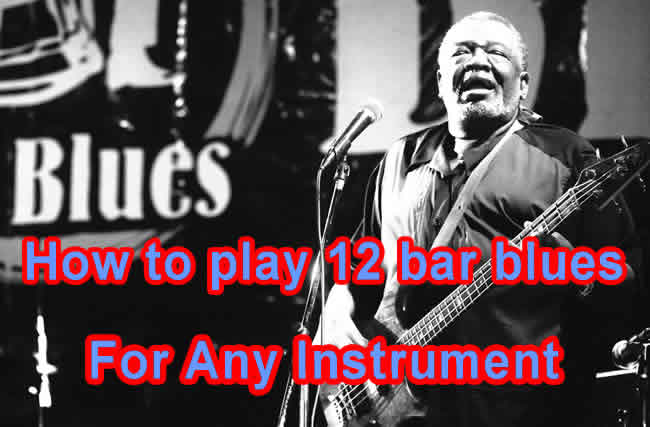Learning The Twelve-bar Blues
Simple How To guide by Rick Townend for ANY INSTRUMENT
| Share page | Visit Us On FB |

The basic form of 12 bar blues
The twelve bar blues may have had its origins in Africa, but it developed into an important part of today's music in America. It's a chord sequence which has lent itself to work songs, deeply melancholy blues music, jazz, rock and roll, and country.
In its most basic form it goes like this (in G):
G |
G |
G |
G |
C |
C |
G |
G |
D(7) |
D(7) |
G |
G |
Each letter represents four beats (or strums)
In some of the early recordings the form of the songs is call-and-answer: a leader sings something (first two bars each line) and the chorus sing an 'answer' (for the last two bars each line). You can see that the leader's part is sung first in G (key chord), next in C ('subdominant' or 'IV' chord) and last in D ('dominant' or 'V' chord), while the chorus always answer in the key chord G.
In the classic blues and early country, such as 'Worried Man Blues' as sung by the Carter Family, the first two lines have the same words, which are 'answered' by the last line. As rock music developed, song-writers like Chuck Berry put sophisticated story-lines like 'Johnny B Goode', 'School-day' and 'Roll over Beethoven' on to this basic chord form.
Developments in Jazz and Blues
Most of the more complicated chord development has been by jazz and blues players. Typical of blues is to change the last line (in G) to D7 C(7) G G, and also to play the Cs in the second line as C7ths. The first line is often modified to include a C(7) as well:
G |
C7 |
G |
G7 |
C7 |
C7 |
G |
G |
D7 |
C7 |
G |
G (or D7) |
If you just strum through this chord sequence you will find it already sound much more 'blues-y' than the first basic sequence.
G |
C / C#o |
G |
Dm7/G7 |
C |
Cm6 |
G |
E7 |
Am7 |
D7 |
G /Bbo |
Am7/D7 |
Jazz players introduced the 'Dixieland change' in the second line, and a typical scattering of minor sixths & sevenths and diminished chords - for example:
Development in Old-Time, Bluegrass and Country Music
The chords have kept simple - for example Earl Scruggs' 'Shuckin' the Corn', and Bill Monroe's 'Rocky Road Blues' are both just that original simple pattern. Sometimes extra bits are put in - half bars to whole extra lines - the modern standard Worried Man Blues runs
G |
G |
G |
G |
C |
C |
C |
G |
G |
G |
G |
G |
D(7) |
D(7) |
G |
G |
While 'Sad and Lonesome Day' and other songs repeat the second line:
G |
G |
G |
G |
C |
C |
G |
G |
C |
C |
G |
G |
G |
D(7) |
G |
G |
There's lots of life left in the twelve bar blues - why not have a play with it, and try inventing your own variations!
Rick Townend
You may also be interested to check out other easy tutorials from Rick:
How to play the Bluegrass instruments tutorial by Rick TownendHow To Sing Bluegrass Harmony easy tutorial by Rick townend
Jazz Chords for guitar, A simple guide by Rick Townend.
Bluegrass Your Fiddle - An Easy Insiders guide and tutorial on Bluegrass Fiddling by Rick Townend.
How to set song lyrics to music and easily create a tune - A non-technical guide for hands-on musicians & song writers.
Rick has also produces a set of tutorials for learning bluegrass and oldtimey tunes and songs details HERE.
For a more in depth coverage of Blues and other aspects of Jazz See The Book of Jazz - all aspects of jazz explained.